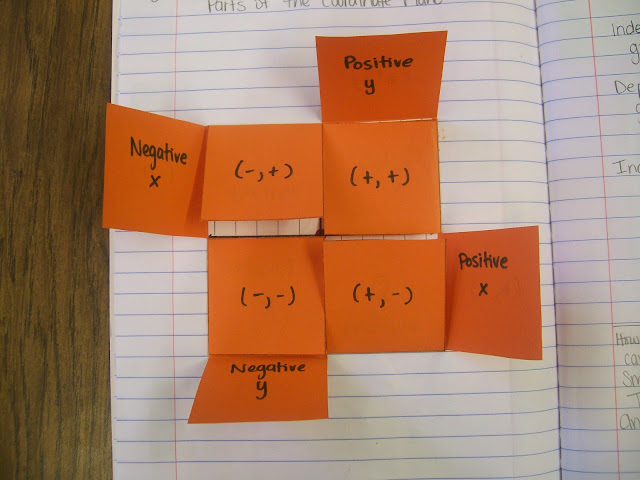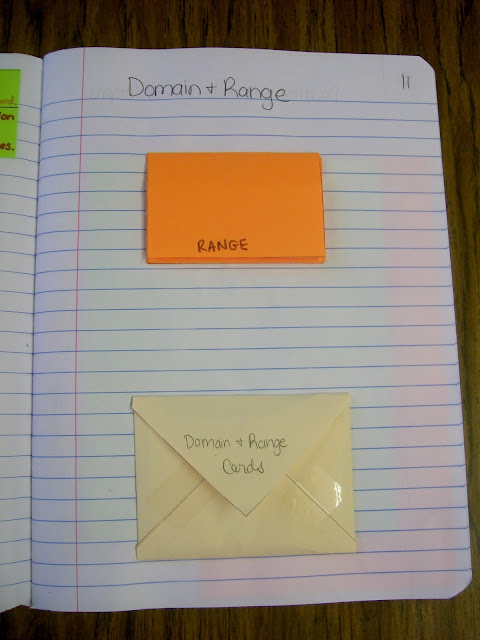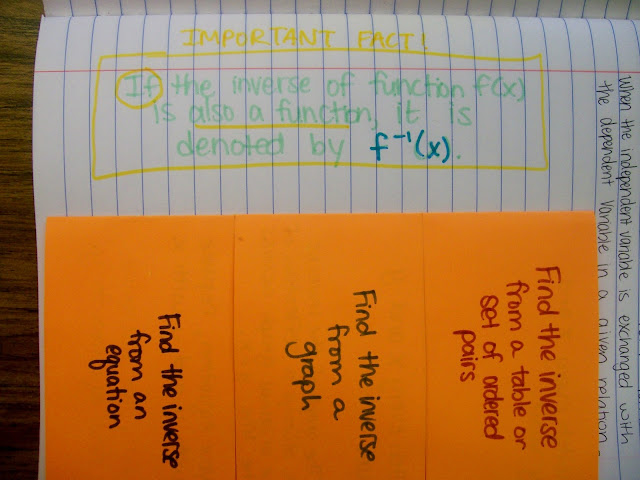This year, I have resolved to do a much better job at the interactive notebook in Algebra 2 than last year. Last year, we had 12 students in my entire school who were enrolled in Algebra 2. This year, that number is just under 40. This is both exciting and kinda terrifying. First of all, it means that more students are prepared and willing to take Algebra 2. At the same time, my Algebra 2 students this year are greater in number and much more varied in level. This presents many challenges. But, these are challenges I am excited to attempt to meet.
Our first unit in Algebra 2 is an introduction to functions, function notation, domain and range, intercepts, maximums and minimums, intervals of increasing and decreasing, finding solutions, and transformations. My goal is to create a foundation which I can build off of once we start linear functions. I am also working hard to prove to my students that they are capable of doing Algebra 2 level work. Many of my students have extremely low confidence. We are also learning how to use the graphing calculator. This is the first experience any of my students have had with a graphing calculator, and I am working hard to make it a positive one.
So far, my Algebra 2 students are loving our interactive notebooks. They thank me on an (almost) daily basis for making Algebra 2 visual, fun, and easy. I have some students who are complaining right now that Algebra 2 is too easy. I told them that they just had to wait. Before they knew it, we would be exploring logarithms, exponentials, conic sections, and all kinds of other exciting mathematical relations. After going on and on about how excited I was about everything we were going to be learning and studying this year, one student asked, "Do you like math?" I was a bit taken aback by this question. Are there math teachers who don't like math? Of course, I like math. I love math! I eat, breath, and sleep math.
As usual, I have embedded the files for these foldables at the end of the post. If you have trouble viewing them, please make sure that you have Flash/Shockwave installed. If that does not correct the problem, please send me an e-mail and let me know what documents you are needing. I will be happy to send them to you!
 |
| My Algebra 2 Interactive Notebook |
 |
| Algebra 2 Unit 1 Table of Contents (Thus Far) |
I have already blogged about the NAGS foldable I had my Algebra 2 students create
here.
 |
| NAGS Foldable - Outside |
 |
| NAGS Foldable - Inside |
 |
| NAGS Chart |
I still haven't found a better way to practice differentiating between function/not a function than this card sort. I blogged about this
last year.
 |
| Function / Not a Function Card Sort |
We also created a Frayer Model for the word "function."
 |
| Function / Vertical Line Test Frayer Model |
I stole this coordinate plane foldable from Ms. Haley and her wonder
Journal Wizard blog! I think this is a big improvement over the coordinate plane foldable I did with my students last year. I created a template for this foldable which I have embedded below.
 |
| Parts of the Coordinate Plane Foldable |
 |
| Parts of the Coordinate Plane Foldable |
 |
| Parts of the Coordinate Plane Foldable |
Our notes over independent and dependent variables were less than exciting. Maybe next year I will come up with a card sort or something. Hmm...
 |
| Independent and Dependent Variable Notes |
Last year, my students had a TERRIBLE time remembering the difference between domain and range. This summer, at the amazing Common Core Training I received from the Oklahoma Geometry and Algebra Project (OGAP), I was introduced to an amazing resource--
Shmoop. They have amazing commentary for each and every high school common core math standard! I learned about the DIXROY acronym from their commentary on F-IF.1.
 |
| Domain and Range Notes - Interactive Notebook |
DIXROY stands for "Domain - Inputs - X-Coordinates and Range - Outputs - Y-Coordinates."
 |
| DIXROY Acronym for Remembering Domain / Range |
I was able to re-use the domain/range notation foldable that I created last year for my Algebra 2 students. My students were VERY confused by the different notations. I haven't yet figured out a way to introduce these notations without overwhelming my students. They recovered, eventually.
 |
| Domain and Range Notation Foldable - Outside |
 |
| Domain and Range Notation Foldable - Inside |
I downloaded the domain and range cards from
this blog post. There are 32 cards which give my students 32 opportunities to practice finding the domain and range!
 |
| Domain and Range Foldable |
We made a tiny envelope to hold our 32 cards. Let me just say - having the students cut out all 32 cards took WAY too much time. I was about ready to pull my hair out. I think we might of spent half of a fifty minute class period just cutting these cards out. But, we used them a lot, so I think it was worth it.
I LOVED the
envelope template that Kathryn (iisanumber.blogspot.com) posted earlier this summer. I downsized her template to the exact size needed to fit the domain and range cards I linked to earlier.
 |
| The Cutest, Tiniest Envelope to Hold our Domain and Range Practice Cards |
Then, I took inspiration once again from Ms. Haley at Journal Wizard. She had her students create an
interactive domain and range finder foldable.
 |
| Domain and Range Foldable (That sadly doesn't photograph well...) |
As you can see, this foldable perfectly holds the domain and range practice cards from our handy-dandy envelope!
 |
| The foldable is made to perfectly hold our domain and range practice cards that are housed in the envelope. |
Students fold over the domain tabs to help them determine the left-most and right-most points on the graph. If the graph goes approaches negative or positive infinity, the students leave the flap open where it reads positive or negative infinity. I wanted my treatment of domain and range to be much more hands-on this year, and I think this foldable does the trick!
After doing many, many cards together, I had students find the domain and range of all 32 cards as homework. They had to write the domain and range in both interval and algebraic notation. (And, the discrete graphs had to have their domain written in set notation.) The next day, I gave them an answer key to use the check their work.
 |
| The Domain and Range Foldable in Action |
One of the main thing my students need to be able to do on their Algebra 2 EOI is to describe graphs. This foldable is an attempt to introduce my students to the concepts of x-intercepts, y-intercepts, relative maximums, relative minimums, increasing intervals, decreasing intervals, roots, solutions, and zeros.
 |
| Describing Characteristics of Graphs Foldable - Outside |
Because there is so much information on this one foldable, this was a perfect opportunity to use COLOR WITH A PURPOSE. Each term was marked with a different color. And the corresponding part of the graph was marked with the same color. This is one of my favorite foldables that we have done this year!
 |
Describing Characteristics of Graphs Foldable - Inside
AKA - Proof I LOVE color-coding! |
I've posted some close-ups of the flaps if you'd like to see what I had my students write.
 |
| Close-up of Right Flaps |
 |
| Close-Up of Left Flaps |
Last year, my Algebra 2 students really struggled with the concept of an inverse. So, this year, I decided to start talking about inverses very early in the school year. This will allow us to revisit the concept over and over as we explore different types of function in a much more in depth manner. By the time the EOI rolls around, my students should no longer be scared when they see the word inverse!
This foldable was inspired by
@druinok's post from February.
 |
| Inverse of a Function Foldable - Outside |
I want my students to be able to find the inverse if they are given a set of points, a graph, or an equation. Since we have only just started exploring functions in general, the examples we went through were quite simplistic. We will explore much more complicated inverses as the year progresses!
A lot of my students were terrified when I told them that we would be learning about inverses. By the end of the lesson, they were amazed that inverses were actually quite easy.
 |
| Inverse of a Function Foldable - Inside |
 |
| Inverse of a Function - Important Fact! |
I still have to figure out how I want to introduce transformations to my Algebra 2 students. That topic should end our first unit. Hmm...
Embedded Files are Below:
Unit Table of Contents
NAGS Foldable
NAGS Chart
Coordinate Plane Foldable
DIXROY (Domain and Range) Graphic Organizer
Blank 3 Door Foldable for Domain/Range Notation Foldable
Interactive Domain and Range Finder Foldable (And Tiny Envelope Pattern from
iisanumber.blogspot.com Describing Graphs Foldable


























